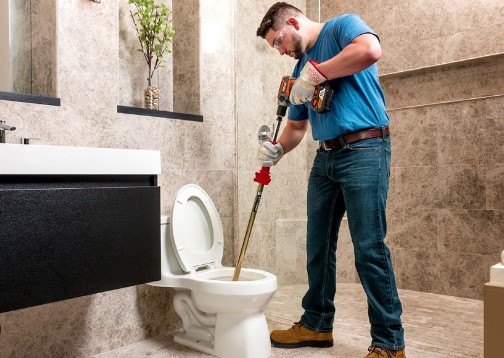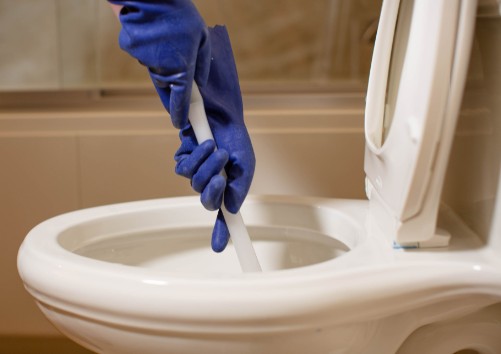Oh, bummer, I accidentally flushed a tampon down the toilet and now wonder if it’s clogged. Unless you want to clog your toilet, there are things you cannot flush, including tampons, but sometimes accidents happen, and if they do, the most important thing to do is remedy the situation.
If you accidentally flush your tampon, don’t flush your toilet again. Try to retrieve it if it is still within reach. However, if it’s too far gone, retrieve it with an auger or dissolve it with chemicals.
Tampons will absorb the water and expand if you drop them down your toilet, potentially causing a clog. Also, these products don’t disintegrate, which is why you will see sanitary bins in public toilets to ensure you don’t flush them away.
So, what should you do if you flush it accidentally? Find out below.

What Should I Do If I Accidentally Flushed A Tampon Down The Toilet?
It is in your best interests to avoid flushing your tampons down the toilet because that will cause frequent clogs and even more severe issues. However, you must know how to address it, just in case.
Do the following:
1. Don’t Flush Your Toilet Again
Flushing the toilet after accidentally dropping a tampon will push it further into your plumbing, making it hard to get it out and causing a blockage. Therefore, avoid doing so.
2. Retrieve The Tampon Manually
You can try to retrieve the tampon by hand if you can still see it, and it hasn’t gone too far down the plumbing. However, this approach can get messy.
Do the following:
- Put on a pair of gloves to maintain hygiene and prevent direct contact with the tampon.
- Grasp and retrieve the tampon with tongs or a long-reaching tool if the tampon is within reach. However, do not push it deeper into the pipes while attempting to grab it.
- Pull it out gently and steadily once you firmly grip the tampon. Do not use excessive force because that can cause the tampon to break or get lodged deeper into the plumbing.
3. Use A Plunger
Before bringing in the big guns- a plumber’s snake, try using a plunger to dislodge the tampon. Select a plunger specifically designed for toilets, often called a flange plunger or toilet plunger.
Toilet plungers have a flange, or an extension, that fits into the toilet drain to create a better seal. Here’s how to use a plunger:
- Place the plunger into the toilet bowl, ensuring the flange is fully submerged in water. The water helps create a seal and provides the necessary pressure to dislodge the blockage.
- Hold the plunger’s handle firmly and press it down gently for a proper seal around the opening of the drain. Ensure your plunger fully covers the drain.
- Create a pumping motion with your plunger by pushing it down and up. The pressure the plunging action creates can help dislodge the tampon and clear the blockage. Repeat this motion several times.
- Once you’ve plunged several times, check if the blockage is cleared by flushing flush the toilet. If the water drains properly, then the blockage has likely been resolved.
4. Retrieve The Tampon With A Plumber’s Snake (Auger)
An auger is best suited to get out the tampon if it’s too far gone. Purchase or rent a plumber’s snake if you don’t have one.
Ensure your plumber’s snake is long enough to reach the tampon. If you are shopping for one, consider DrainX Drain Auger Pro (View on Amazon); that comes in 25ft, 30ft, and 50ft options and has a storage bag and work gloves.
Once you have your plumber’s snake, do these to retrieve the tampon:
- Extend the auger to its full length and ensure it is securely locked. The manufacturer’s instructions will guide you.
- Carefully insert the auger’s end into the toilet drain opening, then slowly push it in while applying gentle pressure. Next, rotate the handle of the plumber’s snake as needed to help it advance through the pipe.
- Continue feeding your plumber’s snake into your toilet drain until you encounter the tampon or feel resistance. The auger’s extended end should help catch the tampon. Once you’ve made contact, rotate the auger’s handle to engage the tampon and carefully pull it out.
- After successfully removing the tampon, flush the toilet to ensure proper water flow. Clean the auger thoroughly and sanitize the area to maintain hygiene.
5. Dissolve The Tampon With Chemicals
Before discussing this approach, note that introducing chemicals into your toilet or plumbing can damage the pipes or cause other harmful effects. Therefore, please don’t make a habit of it.
With that said, some chemicals dissolve tampons. Worthy options include Drano, hydrochloric acid, sulfuric acid, nitric acid, urea, and Schweizer’s agent.
Pour Drano into your toilet to dissolve tampons made of cotton, not synthetic butdon’t leave Drano sitting for too long because it’s a powerful chemical. It triggers a chain reaction that decomposes the tampon.

How Do I Know My Toilet Is Clogged?
Flushing a tampon doesn’t always cause a blockage. Also, determining whether a tampon clogged your toilet can be challenging without directly observing the blockage. So, how do you know you have a clogged toilet?
Check for these signs:
i) Flushing Difficulty
You are likely dealing with a blockage if you experience difficulties flushing the toilet, such as weak flushing power, incomplete flushes, or rising water levels above normal.
ii) Water Backup
When a tampon or any other material causes a clog, it can prevent water from draining properly. If this happens, you may notice the water level in the toilet bowl rising higher than usual or taking longer to go down after flushing.
iii) Unusual Sounds Or Gurgling
A clogged toilet can produce unusual sounds, such as gurgling or bubbling noises when you attempt to flush. This happens because the blockage is impeding the flow of water.
iv) Foul Odor
Your toilet will emit a foul smell if the tampon stays stuck inside your toilet for a prolonged period. This results from the decomposition of organic materials.
Will Flushing One Tampon Down The Toilet Clog It?
Flushing a single tampon can cause a clog, but that’s not always the case. The outcome of flushing a tampon varies depending on the toilet and plumbing system, tampon size and absorbency, presence of other obstructions, and improper toilet use.
Some toilets and plumbing systems are more susceptible to clogs compared to others. Also, some tampons are designed to disintegrate when exposed to water, but if they encounter an obstacle or the plumbing system has poor water flow, they may not break down effectively.
Moreover, flushing non-flushable items or excessive toilet paper can increase the likelihood of a clog.
How Many Tampons Does It Take To Clog A Toilet?
There is no specific number for the number of tampons it takes to clog a toilet. However, flushing multiple tampons increases the risk of a blockage as it can overwhelm the plumbing system and create a higher chance of obstruction.
Nonetheless, flushing tampons, regardless of the quantity, is generally not recommended as they can cause plumbing issues. This applies to tampons labeled flushable as well. In that case, always dispose of your tampons in the trash.
How Long Can Tampons Stay In Pipes?
Tampons can take up to 6 months or longer to break down and move through the pipes. The exact duration varies depending on the tampon’s composition, water flow, and plumbing system efficiency.
In some cases, tampons may break down relatively quickly; in others, they can remain intact and cause clogs or blockages in the plumbing system.
Is It Okay To Flush A Used Tampon?
Flushing a used tampon down the toilet is not okay. While some tampons are labeled flushable, you are better off keeping them out of your toilet and plumbing pipes.
But why is it not okay to flush a tampon? Below are the reasons:
- Tampons absorb fluids and expand in size upon contact with a liquid. As their size increases, they can cause plumbing issues, such as clogs or blockages.
- Tampons do not disintegrate easily in water. They can retain their shape and size, leading to potential clogs in the plumbing system. Tampons can get stuck in the pipes, trap other debris, and cause blockages that may require professional assistance to clear.
- Flushing tampons adds unnecessary strain on the sewer system. Municipal sewage systems handle toilet paper, water, and human waste. Therefore, flushing items like tampons can contribute to sewer backups, sewage treatment problems, and environmental issues.
- Tampons, along with other non-biodegradable materials, can end up in water bodies or contribute to landfill waste when flushed. This can adversely affect the environment, wildlife, and aquatic ecosystems.
- Clearing a clogged plumbing system can be expensive and time-consuming. Hiring a professional plumber to fix a tampon-related blockage can be costly, especially if the issue requires extensive repairs or pipe replacement.

What Happens If You Flush One Tampon Down The Toilet?
Here are the possible outcomes of flushing one tampon down the toilet.
1) Smooth Passage
The tampon can pass through the plumbing system without causing any issues. It might break down or disintegrate as it travels through the pipes and eventually reach the sewage system.
2) Partial Blockage
Depending on the size of the tampon and the condition of your plumbing system, the tampon can get stuck along the way. It might partially block the pipes, leading to slower water flow, improper drainage, or occasional backups.
3) Complete Blockage
In more severe cases, the tampon can cause a complete blockage in the plumbing system, resulting in water backup, toilet overflow, or an inability to flush correctly.
Note that even if a single tampon flushes smoothly once, it does not guarantee that future flushes will be trouble-free. Accumulation of additional waste or other factors can contribute to clogs over time.
Summary of I Accidentally Flushed A Tampon Down The Toilet
A tampon may be tiny, but it can be a significant issue on your toilet if you flush it. Consider yourself lucky if it flows through your plumbing pipes without causing an obstruction. However, should it cause a clog, I believe you now know what to do.
